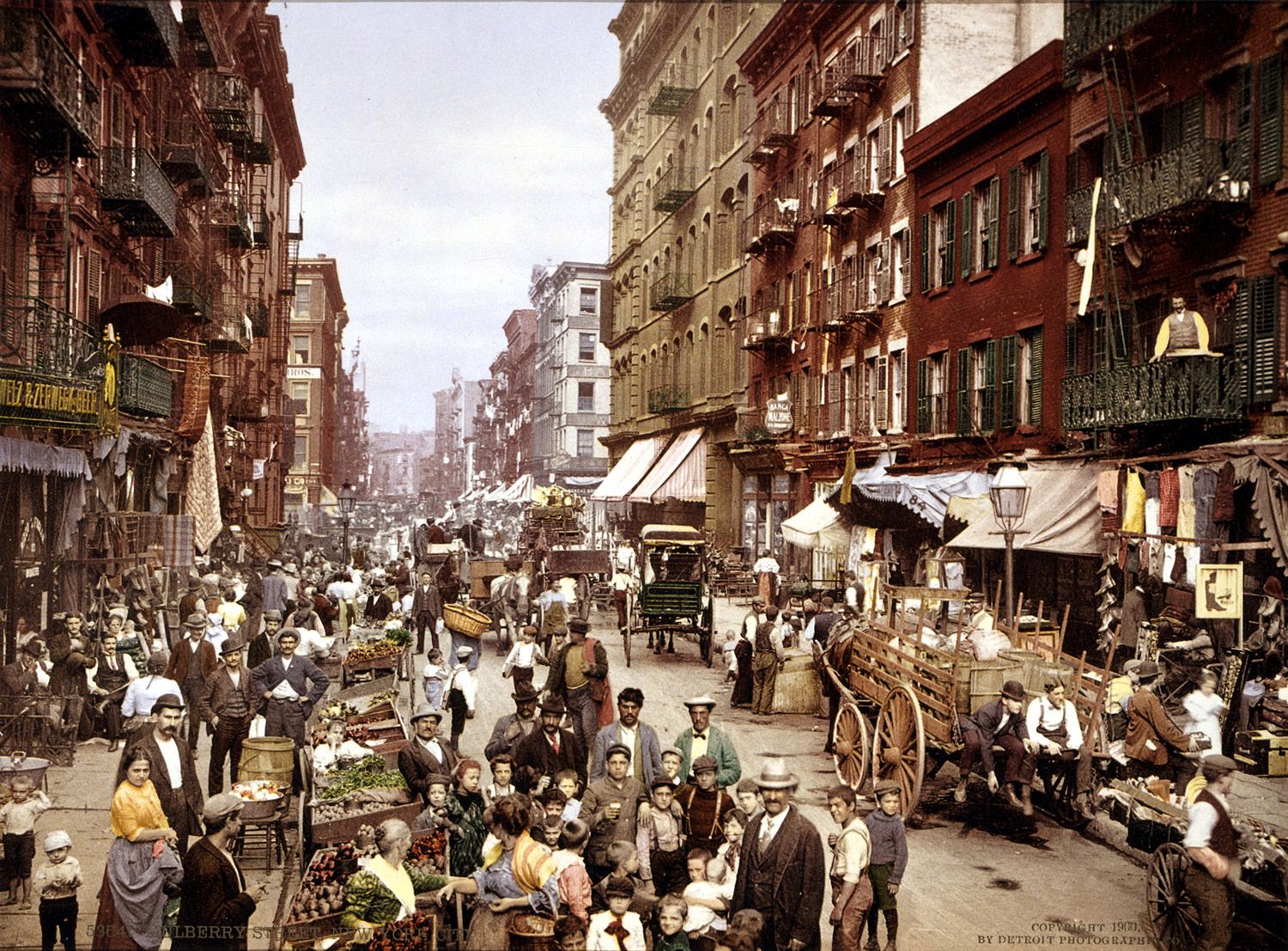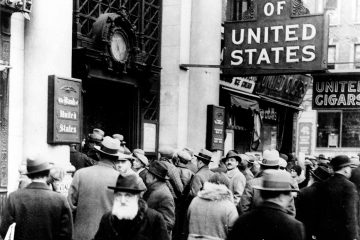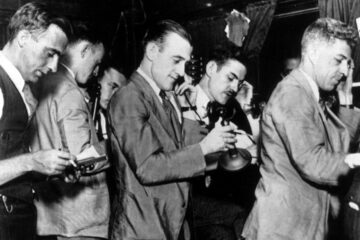What Happened in Business: 1900
| « 1899 | 1901 » |
 Summary: Growth Year ꜛ
Summary: Growth Year ꜛ
U.S. President: William McKinley
DJIA End of Year Close: 66.07
Top Stocks: Union Pacific Railroad, Northern Pacific Railway, American Tobacco Company*
Media: Newspaper, Mail, Magazine, Telegraph, Posters, Catalogs, Typewriters
Wealthiest American: John D. Rockefeller
U.S. Population: 76 million
Era: Progressive Era (1890s–1920s)
Key Events & Dates
Gold Standard Act (March 14, 1900):
The Gold Standard Act is enacted, officially placing the United States on the gold standard and defining the value of the U.S. dollar in terms of gold.
Continued Expansion of Railroad Networks:
Ongoing expansion and consolidation of railroad networks contribute to the economic development and connectivity of various regions in the United States.
Antitrust Enforcement:
Antitrust laws, including the Sherman Antitrust Act of 1890, are actively enforced, leading to increased scrutiny of major corporations and efforts to curb monopolistic practices.
Knox Automobile Company Established (1900):
The Knox Automobile Company is founded, contributing to the early development of the American automobile industry.
Expansion of Consumer Goods Industries:
The early 1900s witness the rise of consumer goods industries, with companies focusing on mass production and marketing to meet increasing demand.
Hawaii Becomes a U.S. Territory (June 14, 1900):
The Organic Act of 1900 is enacted, formally annexing Hawaii as a U.S. territory and establishing a government for the islands.
Boxer Rebellion (June 20, 1900):
The Boxer Rebellion in China prompts the U.S. to participate in an international military intervention alongside other Western nations to protect foreign nationals and interests.
Kodak Brownie Camera (February 1, 1900):
Eastman Kodak introduced the Brownie, a simple and affordable camera that played a crucial role in popularizing amateur photography. It was a significant step in making photography accessible to the general public.
First Radio Transmission of Voice (December 1900):
Reginald Fessenden conducted the first known radio broadcast, transmitting a program of voice. On 23 December 1900, at Cobb Island, Maryland, Fessenden successfully transmitted his voice over a distance of 1.6 km (one mile) for the first time using amplitude modulation. This event laid the foundation for the development of radio broadcasting.
Galveston Hurricane (September 8, 1900):
The Galveston hurricane struck the city of Galveston, Texas, becoming one of the deadliest natural disasters in U.S. history. The hurricane and resulting storm surge caused widespread destruction and resulted in a significant loss of life along with significant local economic and business impacts.
Consumer Brands of the Era
In the year 1900, the concept of modern branding was still developing, and many consumer products were sold without the prominent brand names we are accustomed to today. However, there were some notable companies and products that existed during this period:
Coca-Cola:
Coca-Cola, invented in 1886, was becoming a popular beverage in the early 1900s. The iconic brand was already establishing itself as a household name.
Sears, Roebuck and Co.:
While not a consumer product brand per se, Sears, Roebuck and Co. was a significant retail brand, known for its mail-order catalog offering a wide range of products, from clothing to household goods.
Quaker Oats:
Quaker Oats, founded in the late 19th century, was one of the early pioneers in packaged oatmeal products. The Quaker Oats brand became synonymous with oatmeal.
Ivory Soap:
Ivory Soap, produced by Procter & Gamble, was a well-known brand of soap in the early 1900s. It was marketed as a pure and gentle soap.
Kodak:
Eastman Kodak was a prominent brand associated with cameras and photographic equipment. The Kodak Brownie camera, introduced in 1900, played a significant role in popularizing amateur photography.
Colgate:
Colgate, a company with a history dating back to the early 19th century, was known for its personal care products, including toothpaste and soap.
Hershey’s:
The Hershey Company, founded by Milton Hershey in the late 19th century, was already producing chocolate products, including the iconic Hershey’s Milk Chocolate Bar.
Wrigley’s:
Wrigley’s, known for its chewing gum, was becoming a recognizable brand. The company’s popular gum, Wrigley’s Spearmint, was introduced in the early 20th century.
Heinz:
H.J. Heinz Company, famous for its ketchup and other condiments, was a well-established brand by 1900. The company’s commitment to quality and purity contributed to its success.
Gillette:
Gillette, founded by King C. Gillette, introduced the safety razor in 1901, revolutionizing the shaving industry. The Gillette brand quickly became associated with shaving products.
It’s important to note that branding and advertising during this period were not as pervasive or sophisticated as they are today. Many products were sold without extensive marketing campaigns, and regional or local brands were often more prevalent. The early 1900s marked the beginning of a shift toward a more consumer-oriented culture, with recognizable brands starting to emerge.
Key Leaders, Innovators, & Influencers of the Era
In the year 1900, several influential business leaders played pivotal roles in shaping the American business landscape. Here are some of the top business leaders during that time:
John D. Rockefeller:
Founder of Standard Oil, John D. Rockefeller was a dominant figure in the oil industry, controlling a significant portion of the market.
Andrew Carnegie:
A leading industrialist in the steel industry, Andrew Carnegie founded Carnegie Steel Company, which later became part of U.S. Steel.
J.P. Morgan:
J.P. Morgan was a powerful financier and banker, known for his role in the formation of U.S. Steel and his influence in the financial sector.
Henry Ford:
Founder of the Ford Motor Company in 1903, Henry Ford revolutionized the automobile industry with innovations like the assembly line.
Thomas Edison:
An inventor and businessman, Thomas Edison played a significant role in the development of the electric power industry and co-founded General Electric.
George Eastman:
Founder of Eastman Kodak Company, George Eastman revolutionized photography with the introduction of the Kodak camera and roll film.
Cornelius Vanderbilt II:
A prominent figure in the railroad industry, Cornelius Vanderbilt II played a key role in the expansion and modernization of railroads.
Isaac Merritt Singer:
Founder of the Singer Sewing Machine Company, Isaac Singer played a crucial role in popularizing and advancing sewing machine technology.
George Westinghouse:
An inventor and entrepreneur, George Westinghouse was a key figure in the development of the electrical industry, known for his contributions to alternating current (AC) systems.
Philip Danforth Armour:
Co-founder of Armour & Company, Philip D. Armour was a major player in the meatpacking industry, contributing to the growth of the American meatpacking business.
These business leaders were instrumental in the industrialization and economic expansion of the United States during the late 19th and early 20th centuries. Their innovations, investments, and business strategies had a lasting impact on various industries and the nation’s overall development.
* Stocks are examples of some of top, popular traded stocks; however, exact data not available.
| « 1899 | 1901 » |


